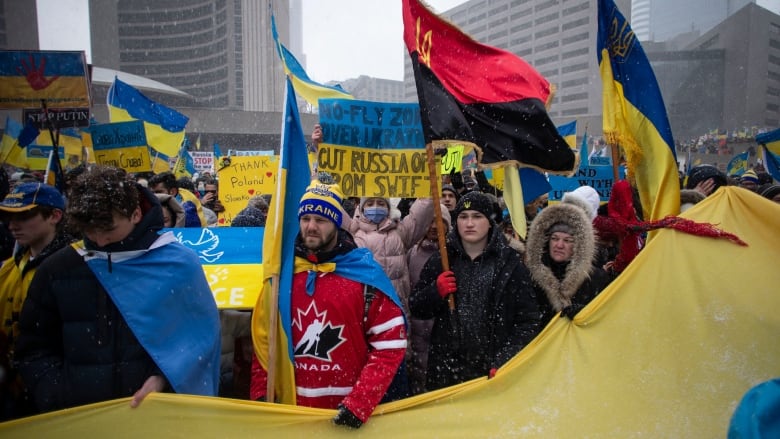Why is the red and black flag, seen at rallies in support of Ukraine, causing such a stir?
Flag symbolizes struggle for independence for some, far-right nationalism and Nazi-era pogroms for others

Among the overwhelming sea of yellow and blue flags at a rally held in support of Ukraine on Sunday in London, Ont.,there were a few different banners showing a red rectangle over abar of black.
Outnumbered by the Ukrainian flag by a ratio of about 20 to one, this flag stirred concerned comments on social media, including a Facebook post that described it as a banner of "Ukrainian neo-Nazis."
The flag has shown up at other rallies in Canada and elsewhereheld in support of Ukraine as the country fights to survivean all-out invasion by Russia.
On Sunday, Canada's deputy prime minister, Chrystia Freeland,found herself ensnared in a debate over the flag when she appeared at a rally in support of Ukraine in Toronto. She tweeted a photo with the caption: "We stand united. We stand with Ukraine."
In the photo, Freelandis shown holding a section ofa black and red scarfbearingthe words "Glory to Ukraine" written in Ukrainian. A day later the tweet was removed, but not before right-leaning media groups accused her of posing with a pro-Nazi banner. A second tweet was sent from Freeland's account showing her without the scarf.
So what is the history of this banner, and why has its presence become so controversial?
It's the flag of theUkrainian Insurgent Army, known by the acronym of its name in Ukrainian, UPA.

History of the UPA
Formed in 1942, the UPA's goal wasto establish an independent Ukrainian state that would carve some territory out of Russia and Poland.
The UPAwas aparamilitary group affiliated with the Organization of Ukrainian Nationalists (OUN), a political organization formed in 1929.
After the start of the Nazi invasion of the Soviet Union in June 1941, members ofOUN, and later UPA, collaborated with the Nazis andwere involved in the killing and displacementof tens ofthousands of ethnic Poles, most notoriously in the Volyn, or Wolyn, region of northwest Ukraine between 1943 and 1944.

Jake Hyman, a spokespersonwith the Anti-Defamation League, a Jewish civil rights group based in New York, said that while the group would later end up opposing the Germans, as well as the Soviets,some UPA/OUNmembers took part in Ukrainian auxiliary units that killed Jews or were involved in early pogroms in the 1940s.
Jars Balan, who heads the Ukrainian Canadian Studies Centre at the University of Alberta in Edmonton, said the UPA was the paramilitary arm of the OUN, a relationship not unlike the historical affiliation between Sinn Finand the Irish Republican Army.
Balanadmits the UPA was not averse to using violence at a time whenUkrainians' desire for independence put them in conflict, at various points, withNazi Germany, Russiaand Polish nationalists.
However, he said the red and black colours used in the flag are an expression of Ukrainian nationalism that long pre-dates fascism and the Second World War, with references to thosecolours showing up in Slavic songs and poetry that date as far back as the 12th century.
"The red is for love and the black is for sorrow and how they are intertwined," Balansaid of the earlier symbolism.
Later, those colours became associated with Ukrainian nationalism.

"The people who are waving them are the people who identify with the tradition of militant Ukrainian nationalism. They respect the fact that the OUN and UPA took up arms in the struggle for Ukrainian independence," Balan said. "They realized this was not going to be achieved in a ballot box in a dictatorship, and they would have to fight for their independence. And so, in adopting the red and black flag, they really are identifying themselves with that tradition."
There continues to be fierce debate about the role of the OUN and UPAin committing atrocities during the Second World War.
"This is an extremely controversial topic in Ukrainian studies," said Oleksa Drachewych, an assistant history professor ofUkrainian descent who teaches at Western University in London, Ont. "It's really heavily debated."
Resurfacing imagery from history
Balansaid he doesn't dispute the UPA's complicated and at times violent history and wishes that the red and black flag would not be used at ralliesbecause it gives pro-Russian groups an opportunityto falsely describe allUkrainians as Nazis or antisemitic.
He said he believes most who fly the flag noware likely referencing the imagery and emotions associated with Ukraine's long history of armed struggle for independence a struggle that continues asVladimir Putin's invading Russian forces march across the country.
Balan said hedoesn't deny that a far-right, xenophobicelement exists within Ukrainian nationalismbut points out that this is a problem in nationalistic movements in almost every other European country, including Germany and France.
He sees the debate over the red and black flag as a distraction, one he says draws the focus away from the real threat faced by Ukraine.
"The issue in Ukraine right now is pretty clear," Balansaid."There's a genocide taking place before our eyes. Putin's goal is to destroy Ukraine's desire for independence and to destroy those who support it. And he's going to be ruthless in doing it."













_(720p).jpg)


 OFFICIAL HD MUSIC VIDEO.jpg)
.jpg)



























































































